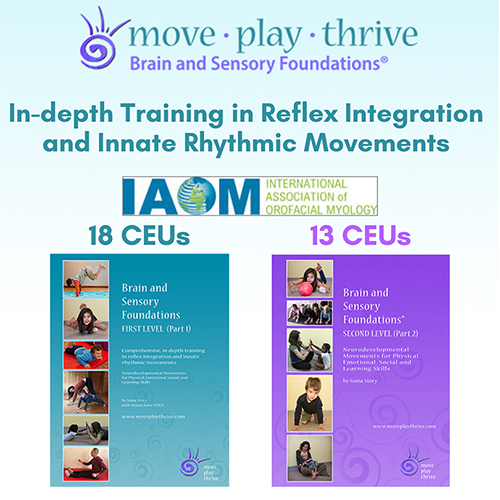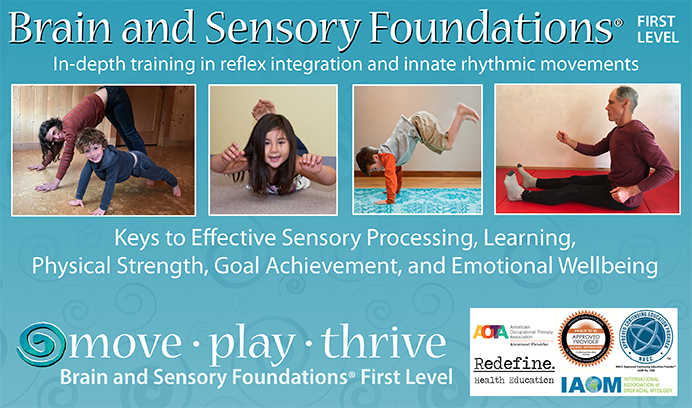For more information about innate movements, subscribe to our free monthly newsletter!
Greetings,
Thanks to Michelle, a Mom with "ADHD Decision Paralysis," we get to celebrate her story of transformation after using neurodevelopmental movements. I know many of us can relate to Michelle's story!
Even after sixteen years, I am awed by these powerful innate movements again and again. We are so blessed to have these tools.
Below Michelle's story are research resources for you and an "All About ADHD" section with engaging articles and inspiring case studies related to ADHD. Plus we have a special announcement for myofunctional therapists.
I look forward to connecting with you, and please share this email with friends and colleagues!
Best wishes,
Sonia
Testimonial: Mom gets relief from ADHD Decision Paralysis
Here is an email excerpt from Michelle, a Mom with ADHD, who is taking the Brain and Sensory Foundations course.
" . . . I have plenty of classic ADHD symptoms plus anxiety and such. My son is diagnosed ADHD and ASD and I quickly realized the apple didn't fall far from the tree, even though I was never diagnosed. I really struggled with juggling my household plus my busy toddler, and found myself with ADHD decision paralysis in many situations, especially with house cleaning and organizing. I just never could get anything done. Executive functioning kept hitting pause, so to speak. I also struggled with chronic migraines that would exhaust me for a day or two whenever they hit.
I started the sessions and began the basic rhythmic movements [from the Brain and Sensory Foundations course] each day, along with the fear paralysis movements taught in Dr. Blomberg's book. I didn't notice much at first except a big increase in dreams, which had been mostly non-existent for the last few years. After the first month, I started doing the rhythmic movements both in the morning and evening, and my motivation to get things done drastically increased. Suddenly I was just tackling countless projects and my decision paralysis diminished. I've now finished more organizing in my house in two months than I have done in the last few years. After my son was born and I was dealing with sleep deprivation, I ended up on Zoloft for a year until my son began sleeping better. I noticed that Zoloft also was a significant booster for executive function for me, and now I feel almost like I am back on Zoloft even though I am not. It's fantastic! I feel like a productive member of society again!
I also found that my chronically tight neck and shoulder started relaxing more . . . My migraines have been less and less severe as I do ATNR exercises twice a day. . ." (Emphasis added).
Thank you "Michelle J" for sharing your outstanding progress with us. Well done Michelle!
RESEARCH
As many of you know, I am in a Master's degree program studying Movement Science. I love to read research articles related to neurodevelopmental movements. Here are some interesting research articles on ADHD for you. Many of these studies show links between unintegrated primitive reflexes and ADHD symptoms. Great thanks to all of these hard-working researchers!
Let me know if these references are helpful! There are many more resources and articles on ADD/ADHD below for you--scroll down to access.
Research Highlight:
In a study of preschool children, Hickey and Feldhacker (2022), found that the activity of certain retained primitive reflexes among males was significantly associated with opposition/defiance (retained ATNR) as well as with inattention (retained Moro reflex). They noted that: “The findings of this study support prior research which indicates a need for early screening of primitive reflexes as client factors which could impact occupational performance” (Hickey & Feldhacker, 2022, p. 1).
Research Studies
Bob, P., Konicarova, J., & Raboch, J. (2021). Disinhibition of primitive reflexes in attention deficit and hyperactivity disorder: Insight into specific mechanisms in girls and boys. Frontiers in Psychiatry, 12.
Gair, S. L., Brown, H. R., Kang, S., Grabell, A. S., & Harvey, E. A. (2021). Early development of comorbidity between symptoms of ADHD and anxiety. Research on Child and Adolescent Psychopathology, 49(3), 311-323.
Gawrilow, C., Stadler, G., Langguth, N., Naumann, A., & Boeck, A. (2016). Physical activity, affect, and cognition in children with symptoms of ADHD. Journal of Attention Disorders, 20(2), 151-162.
Hickey, J., & Feldhacker, D. R. (2022). Primitive reflex retention and attention among preschool children. Journal of Occupational Therapy, Schools, & Early Intervention, 15(1), 1-13.
Iwanaga, R., Ozawa, H., Kawasaki, C., & Tsuchida, R. (2006). Characteristics of the sensory-motor, verbal and cognitive abilities of preschool boys with attention deficit/hyperactivity disorder combined type. Psychiatry and clinical neurosciences, 60(1), 37-45.
Konicarova, J., & Bob, P. (2012). Retained primitive reflexes and ADHD in children. Activitas Nervosa Superior, 54(3), 135-138.
Konicarova, J., Bob, P., & Raboch, J. (2013). Persisting primitive reflexes in medication-naïve girls with attention-deficit and hyperactivity disorder. Neuropsychiatric Disease and Treatment, 9, 1457–1461.
Konicarova, J., & Bob, P. (2013). Asymmetric tonic neck reflex and symptoms of attention deficit and hyperactivity disorder in children. International Journal of Neuroscience, 123(11), 766-769.
Manicolo, O., Grob, A., Lemola, S., & Arx, P. H. (2015). Age-related decline of gait variability in children with attention-deficit/hyperactivity disorder: Support for the maturational delay hypothesis in gait. Gait & Posture, 44, 245–249.
Melillo, R., Leisman, G., Mualem, R., Ornai, A., & Carmeli, E. (2020). Persistent childhood primitive reflex reduction effects on cognitive, sensorimotor, and academic performance in ADHD. Frontiers in Public Health, 8(684).
Salamanca Duque, L. M., Naranjo Aristizábal, M. M., Castro Castro, Á. L., & Calle Jaramillo, G. A. (2016). Asociación de características de trastorno del desarrollo de la coordinación con síntomas de trastorno por déficit de atención con hiperactividad en niños de la ciudad de Manizales. [Association between the characteristics of coordination development disorder and symptoms of attention deficit disorder with hyperactivity in children in the city of Manizales]. Revista Colombiana de Psiquiatría, 45(3), 156-161.
Schatz, D. B., & Rostain, A. L. (2006). ADHD with comorbid anxiety: a review of the current literature. Journal of Attention Disorders, 10(2), 141-149.
Sripada, C. S., Kessler, D., & Angstadt, M. (2014). Lag in maturation of the brain’s intrinsic functional architecture in attention-deficit/hyperactivity disorder. Proceedings of the National Academy of Sciences, 111(39), 14259-14264.
Taylor, M., Houghton, S., & Chapman, E. (2004). Primitive reflexes and attention-deficit/hyperactivity disorder: Developmental origins of classroom dysfunction. International Journal of Special Education, 19(1), 23-37.
All About ADD/ADHD
Case Study
PTSD, ADHD, Depression, Anxiety: Astonishing Changes
If you have not already read this, here is one of our most popular case studies about the transformation of a 20-year-old man with ADHD, sensory issues, trauma, anxiety, and depression.
https://www.moveplaythrive.com/case-studies/item/ptsd-adhd-depression-anxiety-astonishing-changes-2
Articles
Can ADHD be Dissolved?
This article gives supporting research and rationale for how improving sensory-motor skills can lead to more brain maturity and the dissolving of ADHD symptoms.
https://www.moveplaythrive.com/learn-more/item/can-adhd-be-dissolved
Can Movements Help Overcome ADHD?
Read several case studies to see how ADHD symptoms can be greatly reduced and even eliminated by doing brain-changing movements on a regular basis. In addition, you'll get an article showing supporting research and rationale for how improving sensory-motor skills can lead to more brain maturity and the dissolving of ADHD symptoms.
https://moveplaythrive.com/can-movements-help-overcome-adhd
"ADD Is a Manifestation, Not a Diagnosis"
Get a free downloadable chart showing the benefits of using innate neuro-movements, rather than central stimulant medication, to help overcome symptoms of ADD/ADHD.
https://moveplaythrive.com/add-is-a-manifestation-not-a-diagnosis
Dr. Blomberg's case study, "ADHD Diagnosis Cancelled”
Plus, get recent research on Primitive Reflexes and ADHD and ASD.
https://www.moveplaythrive.com/overcoming-adhd-symptoms
CEU course
Using Innate Sensory-Motor Intervention to Help Overcome ADHD Symptoms—Rationale and Supporting Evidence (course sponsored by Integrative OT)
https://www.integrativeed.com/sensory-motor-intervention
|
We're excited to announce that our First and Second Level courses |
Be empowered with the Brain and Sensory Foundations course
Train the Brain for Functional Gain!
-
Learn Innate Rhythmic and Reflex Movement
& Be a Powerful Force for Change

